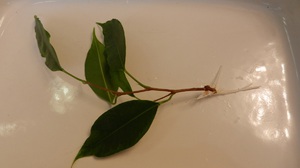
How to propagate small-leaved ficus at home. Reproduction of ficus cuttings, leaf and layering
ficus is ornamental plant, which is located in almost every apartment. It can be both small in size and able to grow to the ceiling. A large number of varieties makes it possible to create various interesting compositions. The plant is unpretentious in care and propagates quite easily.
This must be done at the end of winter or in spring, when the flower from a dormant state enters a phase of intensive growth. So how to propagate ficus at home? This is what we will try to find out.
Ficus propagation
At home, this plant reproduces in the following ways:
- cuttings;
- seeds.
 The latter method is used extremely rarely, as it is very complex and inefficient.
The latter method is used extremely rarely, as it is very complex and inefficient.
Only healthy plants are propagated and this must be done in spring or summer, when the flower begins to grow actively. This ensures the rapid rooting of young shoots.
Preparation of cuttings
Before propagating ficus by cuttings, they should be prepared. This must be done carefully, following certain rules. The branch is cut with a sharp knife, which is directed at an angle to the stem. You can use a blade for this, but not scissors, as they only tear and wrinkle the edges, injuring the tissue, as a result, the roots will form very slowly.
The juice released during this must be washed off, otherwise it will harden and prevent the roots from forming. The cutting should be about 15 cm long. The lower leaves are removed, and the remaining ones, especially if the plant is large-leaved, are folded into a tube and fixed in this position. This helps the flower lose less moisture.
How to root ficus Benjamin?
Prepared cuttings are lowered into water or immediately into the soil. If you root them in water, you need to use dark dishes for this, because light can provoke the reproduction of microscopic algae. The quality of the water in this case will deteriorate significantly and ficus propagation will fail.
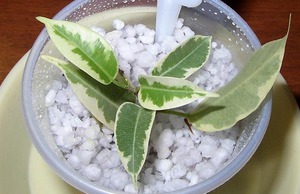 The leaves should not get wet so that rotting does not occur. As the water evaporates, it should be topped up periodically. To create the shoots of the necessary temperature and humidity, they are put up in a greenhouse. H after 2–3 weeks, callus tissue appears on the stems in the form of growths. After some time, roots form in this place. After rooting, the cutting is planted in the soil substrate.
The leaves should not get wet so that rotting does not occur. As the water evaporates, it should be topped up periodically. To create the shoots of the necessary temperature and humidity, they are put up in a greenhouse. H after 2–3 weeks, callus tissue appears on the stems in the form of growths. After some time, roots form in this place. After rooting, the cutting is planted in the soil substrate.
How to speed up the formation of roots?
In a container of water, cuttings of Benjamin's ficus stand for about three weeks, at which time roots are formed. To speed up the reproduction of the flower, you can make shallow scratches in the place of the cutting, which will be located in the ground. Special preparations help to root ficus well, for example, "Kornevin". Before lowering the cuttings into the water, they should be soaked in a solution of this drug. When rooting in the soil, sections should be powdered with a stimulant in the form of a powder.
Ficus should reproduce in good soil. To obtain it, take in equal proportions:
- sand;
- peat;
- vermiculite.
The soil is best disinfected by heating it for 30 minutes in a steam bath. If the length of the handle is several centimeters, it must be fixed in a pot. In this case, a peg should be threaded into the rolled sheet, which is well buried in the soil.
Reproduction by seeds
As mentioned above, this method of reproduction is rather complicated and ineffective, so flower growers rarely resort to it. If this method was chosen, before planting, the seeds are treated with a fungicidal solution or a growth stimulator, after which they are laid out on the surface of the substrate, which should be slightly moistened.
To create greenhouse conditions, the landing is covered with a transparent film. Be sure to maintain the temperature in the range of 25 - 28 degrees. After the emergence of seedlings, it is recommended to put them in a well-lit place, otherwise the seedlings begin to stretch.
Ficus care at home
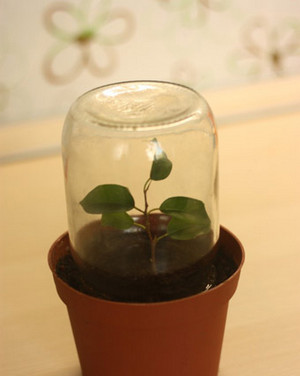 Planted cuttings must be covered with a plastic bag or a transparent jar. Ficus Benjamin is a thermophilic plant, therefore soil must be warm. To warm it up, use a heating pad or a battery. So that the root or ground part does not rot, the plant should be ventilated from time to time.
Planted cuttings must be covered with a plastic bag or a transparent jar. Ficus Benjamin is a thermophilic plant, therefore soil must be warm. To warm it up, use a heating pad or a battery. So that the root or ground part does not rot, the plant should be ventilated from time to time.
Therefore, it is imperative to spray the plant, especially in summer. It is recommended to bathe the ficus once a week under a warm shower or simply wipe the stems and leaves with it. The earth, on the other hand, should never be waterlogged. and between watering the top layer must dry out. Stagnation of water in the pot contributes to the decay of the roots and the death of the plant.
As a result of improper care, the ficus weakens. Reproduction of this flower at home is possible only when it was originally healthy and strong.
Since the juice can flow out of a fresh cut for quite a long time, it must be sprinkled with crushed charcoal or pressed with a cotton swab.
Young ficus must be placed in a place that is well lit. Lack of light leads to stretching of the internode, as a result of which the plant acquires an unaesthetic appearance.
This flower does not like being moved from place to place. Stress can take a toll on him. The leaves begin to turn yellow and fall off from sharp temperature fluctuations or lighting changes.
Several people have already asked me whether it is possible to propagate a ficus with a leaf, such as Saintpaulia.


The answer is simple: no, you can't. And this applies to all ficuses, not only with "thin" leaves, like Benjamin's ficus, but also with denser, leathery ones.
![]()


Ficuses are propagated by stem cuttings (apical) and air layers. Ficus seeds at home are propagated much less frequently (mainly those species that are rarely found on sale).
The best time to breed ficus cuttings- spring Summer. A green apical shoot is chosen (lignified and strongly semi-lignified take longer to take root; lignified ones may not take root at all) with two or three nodes about 15 cm long. The stalk is cut with a sharp knife (no need to cut obliquely).In this case, the cut must be made below the sheet (knot) by 0.5-1 cm. The bottom sheet is cut off.Cut the middle leaves1/2 length, and the top -can be left or reduced by a third. In large-leaved ficuses with leathery leaves, a cutting with 2-3 nodes is taken in this way, the rest of the cuttings may have more nodes (do not take too long cuttings, however), but the lowest leaves are also removed from them in the middle part of the cutting - cut in half.
Leaf pruning is necessary to reducethe area of evaporation from the remaining leaves, until young roots appear and earn.
For rooting, you can also take stem cuttings (that is, cuttings without the upper part of the shoot, but they do not always give beautiful young shoots after rooting - they usually grow sideways).
After cutting the cutting, the milky juice from the cut is washed off with running water. You can instead put the stalk in a glass of water for a while.
You can root in a soil mixture, in water, in sand, in a mixture of vermiculite + sand, in moistened sphagnum moss, etc. Before placing the cutting in a pot, it can be dipped in phytohormone powder. This procedure accelerates root formation in the cutting.
cuttingimmerseinto the moistened soil mixture so that the lower dormant bud (the node where the bottom leaf was cut off) is in the soil mixture at a depth of 1-2 cm. The soil mixture is lightly tamped around the cutting. The pot with the handle is placed in a warm place (the temperature should not fall below+25°C). In cooler conditions, be sure to make a greenhouse: cover the pot with the handle with a plastic bag or a cut bottle, you can cover it with a glass jar. Periodically, the greenhouse is slightly opened for ventilation. The substrate must always be moistened (not waterlogged!).
Usually cuttings take root within 1-1.5 months.If the cutting is rooted in water or in sphagum, then one should not wait until the roots that have appeared grow strongly. 0.5-1 cm of roots is enough to plant a cutting in a pot. This must be done carefully so as not to break off the young roots.
Air layers propagate ficuses with thick stems.

A variety of decorative ficuses will allow you to create a winter garden on the windowsill. These flowers are endowed with amazing properties - protecting the house from bad energy, the ability to bring happiness to the family, and the like. But to create a winter garden in an apartment, it is important to know how to propagate ficus at home. This is also available to a novice florist.
We propagate ficus at home - the main rules
There are three options for plant propagation:
- air layers;
- cuttings;
- branch with a leaf.
Regardless of the type of ficus and the method of reproduction, consider the following rules:
- take care of breeding these plants in spring or early summer. Ficus is afraid of sudden temperature changes in winter. Climate change will become stressful and the plant will die;
- the new flower cannot stand bright sunlight. Place the pot with the planted ficus in the shade;
- when using the cutting method, be sure to rinse the cut area with warm water, juice comes out of it. Then leave the branch to lie aside so that the cut dries out a little;
- do not take young shoots for cuttings. They don't fit. Use older shoots for propagation.
We propagate ficus at home by cuttings
You will have to use cuttings of an adult ficus. He must be at least two years old. Have scissors or a sharp knife ready. Breeding process:
- put a pot of adult ficus on the table. Cover the surface in advance with oilcloth or paper;
- count 15-17 cm from the top of the flower. The distance to the first node should be approximately 1 cm;
- cut at an angle the apical cutting 15 cm long. You can also take cuttings from the stem with three leaves;
- Carefully remove all leaves from the cutting and place it in a bowl of water.
For rapid growth of the plant, put it in a warm place for 3-4 weeks. It is advisable to make a small greenhouse. The optimum temperature for rooting is 24 degrees Celsius. We saw that young leaves appeared on the branch - plant the plant in a pot with soil. Use sand and peat as soil. Use a small pot for planting. Insufficiently rooted shoots can be wrapped with polyethylene. Then accustom the flower to the home climate.
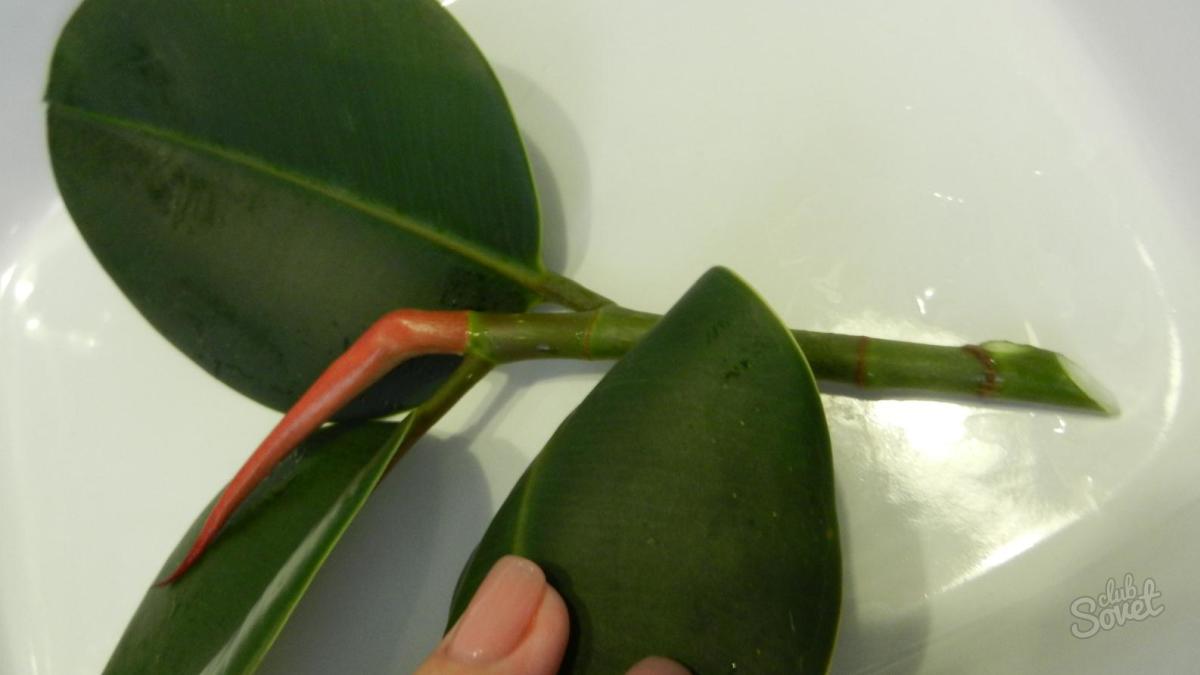
We propagate ficus at home with a branch with a leaf
You can propagate the flower with cuttings with young green leaves. Cut it as indicated in the second paragraph. But choose the place of the cut on the trunk of the ficus along the lowest internode. Plant the finished shoot immediately into the ground to the base of the leaf. Carefully twist the leaves on the branch into a tube and wrap with a soft thread or elastic band for reliability. Place the flower for rooting in a room with a temperature of 27 degrees Celsius. Further care for young ficus is similar to conventional cuttings. After 3-4 weeks, the young flower will take root, and you will see the first shoots.
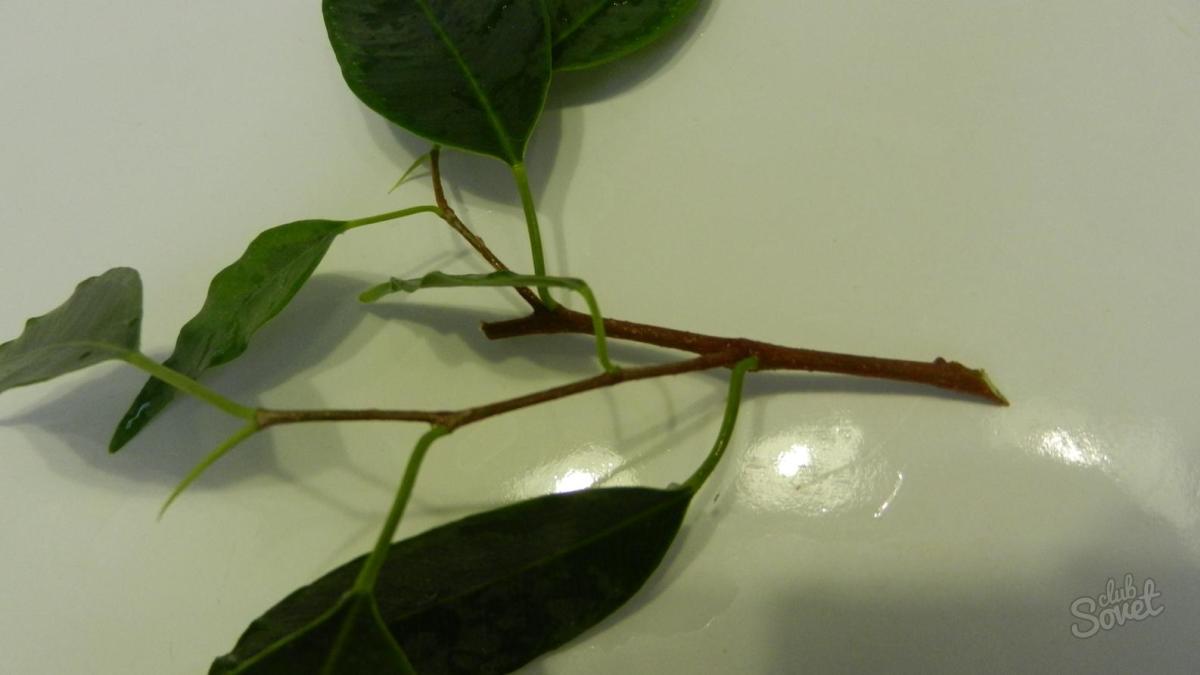
We propagate ficus at home by air layering
This method of reproduction is used if the ficus stem is very bare. Your actions are as follows:
- decide at what height of the ficus trunk you want to get layering;
- remove the leaf from the trunk and in its place make a shallow incision with a blade or clerical knife;
- remove with cotton wool the liquid that flows from the "wound";
- place a chip or match in the incision;
- cover this place with slightly damp moss and cover with cling film. Leave some air under the film and fix it securely on the barrel. Make sure that the moss does not dry out while rooting takes place.
After a month, you will see young roots under the film at the incision site. Do not remove the film until the moss has grown roots. Well, if they break through it. Cut off new shoots and plant young ficuses in separate pots with peat.
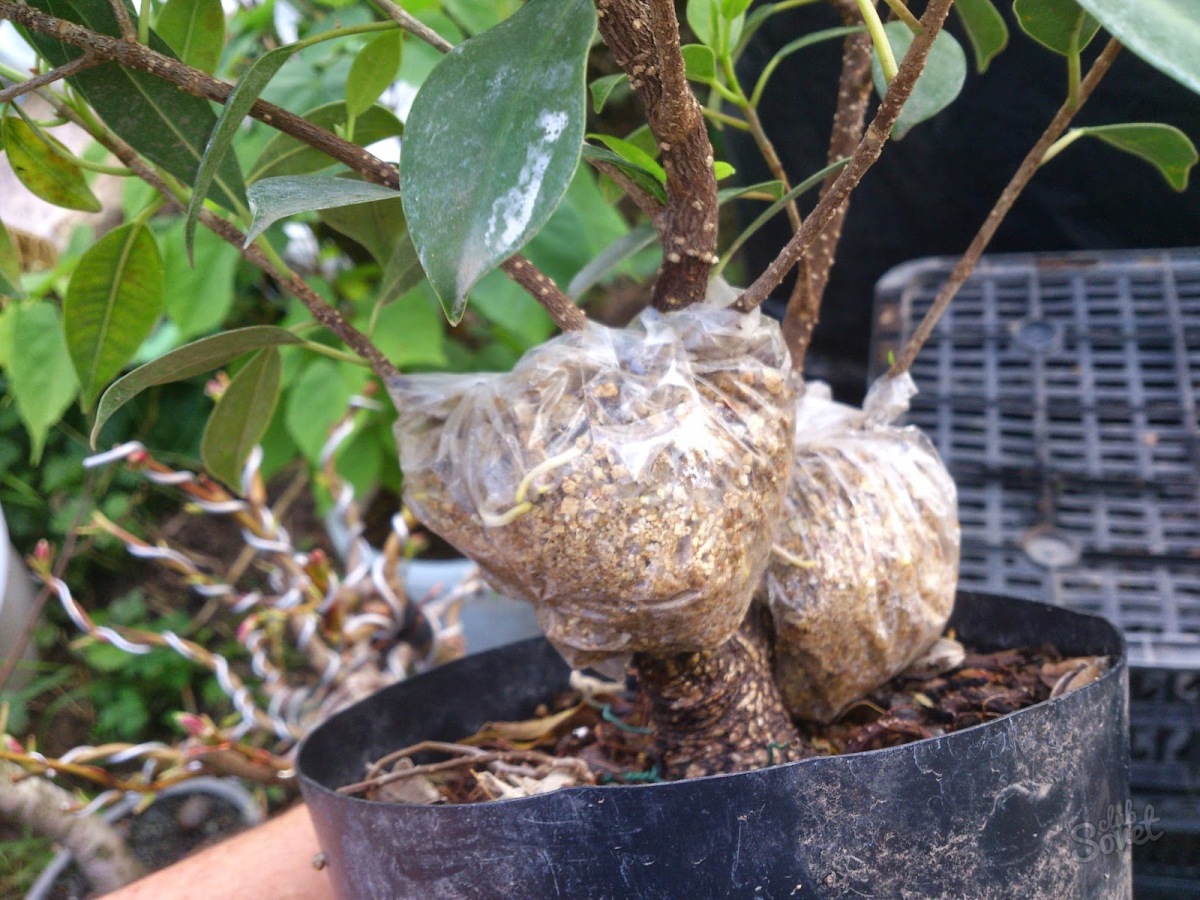
Experienced flower growers consider cuttings and propagation by air layering to be the best ways. Choose what is convenient for you and plant a winter greenhouse on the windowsill.
There are several ways to propagate ficuses: cuttings, horizontal and air layering, cloning and seeds. best time breeding period is from March to September. This will allow the young plant to gain strength and prepare for winter.
Propagation of ficus cuttings
cuttings- This is the easiest and most common method of reproduction.
First you need to prepare the plant. The day before work, you need to carefully water the plant, so that the cuttings are abundantly saturated with moisture. This will help the plant take root better.
You have to choose apical semi-lignified cutting. It should be 10-15 cm. It must be cut at an angle. 45 degrees sharp blade. Secateurs can damage tissue and slow down the rooting process.
Cuttings of large-leaved species such as Ficus rubber and Ficus lyre should have an average of 2-3 leaves, large leaves are cut in half or carefully twisted to reduce evaporation. The bottom sheet needs to be cut off. On cuttings of small-leaved species (, Ficus microcarpa), shoots are removed at the very bottom.
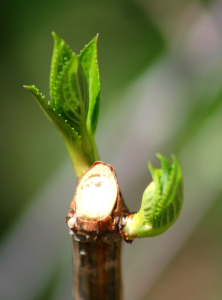
A selection appears in place of the cut - milky juice. It must be removed. To do this, we lower the cutting into a glass of warm water for a couple of hours, after which we dry it.
The large-leaved species of ficus can be propagated not only by apical cuttings, but also by taking the middle parts of the stem containing 2-3 nodes. The process is the same as described above.
For breeding ficus leaves can also be used. They must be taken from the upper or middle part of the stem, while not damaging the node and retaining most of the lower internode.
If you want to know more about reproduction and not only of these species, we recommend that you read the corresponding article.
Ficus: propagation by air layering
layering- these are shoots with roots that are not separated from the mother plant. Propagation of ficus by air layering used for large tree species.
The process of propagation by air layering is quite simple:
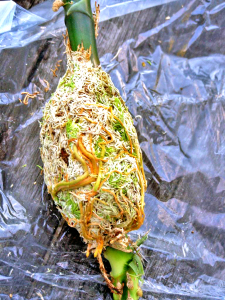
Propagation of ficus by horizontal layering
This method is great for ground cover ficuses(Ficus dwarf, Ficus mountain, Ficus arrow-shaped). Select a section of the stem. We remove a few leaves from it. We press the flexible stem to the ground and deepen it slightly, securing the shoot with a stick or bracket.
When roots appear, layering is necessary cut off the mother ficus and transplant into a separate pot.
Ficus - propagation by seeds
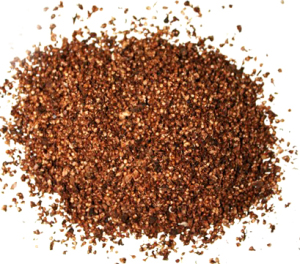 IN it is impossible to get seeds at home due to the lack of insect pollinators. On the ficus sometimes you can find "berries". But these are not berries, and you will not get seeds from them. They look so weird inflorescences.
IN it is impossible to get seeds at home due to the lack of insect pollinators. On the ficus sometimes you can find "berries". But these are not berries, and you will not get seeds from them. They look so weird inflorescences.
To grow ficus from seeds, you need to buy them at a flower shop. Before planting in the soil seeds are processed growth promoters and fungicides. After that, they must be sown on the surface in moist and warm soil. The pot with seeds should be covered with polyethylene and put in heat.
The temperature should vary between 25 and 30 degrees. When shoots appear, the pot must be moved to a well-lit place to avoid stretching the sprouts and ensure their full development.
Ficus cloning
This is an industrial procedure. It is based on the ability of a cell, under certain conditions and with appropriate nutrition, to create a copy of a plant. As a result, the plant is absolutely identical, but free from various infections.
Video
To get a better idea of the propagation of this wonderful plant, watch the video below. It shows the process of ficus cuttings.
Ficus - decorative leafy indoor plant, which has almost every grower. This flower has many varieties and forms. Ficus Benjamin is especially popular, reproduction and care of which is a pleasure. This is a tall shrub with a densely branched crown and variegated foliage. The main thing is that this plant is unpretentious to the conditions of detention and reproduces quite easily.
How can this plant be propagated?
 Reproduction of ficus Benjamin at home is carried out in several ways:
Reproduction of ficus Benjamin at home is carried out in several ways:
- seeds;
- cuttings;
- cloning.
It is important that the plant to be used in the propagation process is healthy. It is best to carry out the cultivation procedure in spring or summer, during the period of active growth of the plant. This will ensure active and rapid rooting of young shoots.
cuttings
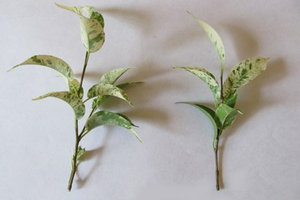 This is a vegetative method of reproduction. Ficus Benjamin can be grown from a branch, that is, cuttings. Almost all varieties of this flower reproduce at home using this method, and it is the most common.
This is a vegetative method of reproduction. Ficus Benjamin can be grown from a branch, that is, cuttings. Almost all varieties of this flower reproduce at home using this method, and it is the most common.
For planting, you need to use apical, semi-lignified shoots about 15 cm long. Cut off the branches with a sharp object, making an incision obliquely. In order not to close the tissue of the shoots when cutting, it is recommended to use a sharp knife. On the cuttings, you need to remove large leaves so that the moisture does not evaporate so quickly. On one handle, on average, there should be 3-4 leaves. Milky juice appears at the cut sites. It dries quickly and prevents cuttings from rooting. Therefore, the branches must be immediately washed under water or placed in a container with water, which must be changed periodically.
 As soon as the juice is gone, we take out the shoots and let them dry. Cuttings dipped in warm water actively and quickly take root. Sometimes the stems can rot, in order to avoid this phenomenon, you need to lower an activated charcoal tablet into a container of water. At this time, the shoots require special care and attention. The leaves on the branches should not touch the water, otherwise they will rot. The container with the cuttings must be placed in a well-lit place without direct sunlight. Periodically, water must be added as it evaporates.
As soon as the juice is gone, we take out the shoots and let them dry. Cuttings dipped in warm water actively and quickly take root. Sometimes the stems can rot, in order to avoid this phenomenon, you need to lower an activated charcoal tablet into a container of water. At this time, the shoots require special care and attention. The leaves on the branches should not touch the water, otherwise they will rot. The container with the cuttings must be placed in a well-lit place without direct sunlight. Periodically, water must be added as it evaporates.
In order to create an increased temperature and humidity for the shoots, they are placed in a greenhouse. After 2-3 weeks, calus tissue should appear on the stems - in the form of growths. In the future, roots will appear in this place. After active rooting, the branches are planted in the soil substrate.
Many flower growers practice propagating Benjamin's ficus by cuttings in a soil mixture that consists of vermiculite, sand, peat and perlite in equal proportions.
Preparation of shoots for planting occurs according to the same principle as in the previous rooting method. Purified from milky juice and dried twigs are processed on slices with crushed charcoal. Then they are lowered into the ground by one kidney.
Caring for rooted bushes
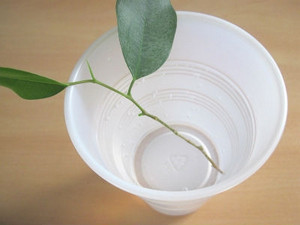 Planted cuttings are recommended to be covered with a transparent jar or polyethylene. Subsequent planting care consists in frequent, but moderate soil moisture so that there is no stagnant water. To avoid decay of the ground and root parts, the plants must be periodically ventilated. Ficus Benjamin is a heat-loving plant, so the soil for it should always be warm. To heat it, you can use a heating pad or a heater, for example, a battery.
Planted cuttings are recommended to be covered with a transparent jar or polyethylene. Subsequent planting care consists in frequent, but moderate soil moisture so that there is no stagnant water. To avoid decay of the ground and root parts, the plants must be periodically ventilated. Ficus Benjamin is a heat-loving plant, so the soil for it should always be warm. To heat it, you can use a heating pad or a heater, for example, a battery.
If new leaves appear on the branches, this means that the cuttings have successfully rooted. Shelter can be removed, but not for long. Plants must gradually adapt to the new temperature and lighting conditions.
Reproduction in a greenhouse
A very popular method of mass reproduction of ficus at home. To do this, you need a well-ripened leafy twig from the main stem. How many leaves the shoot contains, so many cuttings for propagation can be obtained. The cut from above is made above the axillary kidney, from below - we make the cut obliquely. We take for reproduction most of the internodes.
We deepen the prepared cutting into the ground, while the petiole of the leaf should remain on the surface. We turn the leaf into a tube, fixing it with an elastic band. In the middle of the tube, you can set a support that will provide stability to the handle. And so we plant each part of the ficus for rooting, then cover it with polyethylene.
The main care for the shoots is the regular airing of the plantings and the heating of the soil. After 1 month, the branches should take root, this will be noticeable by the newly appeared young leaves.
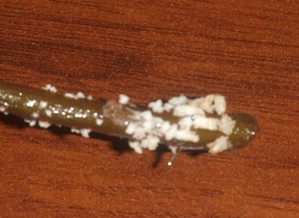 If you make 2-3 cuts on the bottom of the ficus, rooting will be faster. You can also make longitudinal scratches, which will also speed up the process of the appearance of roots. The principle is this - the more wounds on the surface of the stem, the faster the roots appear. Prior to rooting, in the first, in the second case, it is recommended to treat the cut sites with a growth stimulator, or lower the branches into water containing Kornevin.
If you make 2-3 cuts on the bottom of the ficus, rooting will be faster. You can also make longitudinal scratches, which will also speed up the process of the appearance of roots. The principle is this - the more wounds on the surface of the stem, the faster the roots appear. Prior to rooting, in the first, in the second case, it is recommended to treat the cut sites with a growth stimulator, or lower the branches into water containing Kornevin.
For those who are breeding ficus Benjamin for the first time at home, it is advisable to use the rooting method in water.
With this method, it is easier to observe the rooting process of the cuttings, and also, rotting of the leaves and stem can be prevented. For convenience, it is recommended to use containers for seedlings with a removable bottom. In the future, this will facilitate the care and procedure for transplanting into larger pots. Plant transplantation at home is carried out by transshipment of an earthen coma.
seed propagation
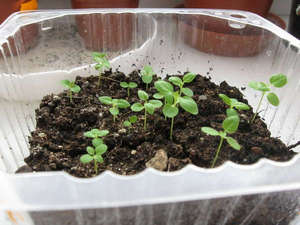 At home, growing Benjamin's ficus using seeds is quite rare, since this process is complex and ineffective. The collected seeds are treated with a growth stimulator or a fungicidal solution before planting. Then they are laid out on the surface of a slightly moistened substrate. Landings need to be covered with a transparent film, creating greenhouse conditions. The main care for seedlings is to ensure a stable temperature regime within 25-28 degrees. As soon as shoots appear, they are exposed in a well-lit place to avoid pulling seedlings.
At home, growing Benjamin's ficus using seeds is quite rare, since this process is complex and ineffective. The collected seeds are treated with a growth stimulator or a fungicidal solution before planting. Then they are laid out on the surface of a slightly moistened substrate. Landings need to be covered with a transparent film, creating greenhouse conditions. The main care for seedlings is to ensure a stable temperature regime within 25-28 degrees. As soon as shoots appear, they are exposed in a well-lit place to avoid pulling seedlings.
Cloning on an industrial scale
 Ficus Benjamin is propagated by an industrial method, which is based on the totipotent properties of plant cells. Complete nutrition of the plant and proper care are the main conditions for the generation process, as a result of which the ficus cell is able to produce an identical plant, that is, to recreate its copy.
Ficus Benjamin is propagated by an industrial method, which is based on the totipotent properties of plant cells. Complete nutrition of the plant and proper care are the main conditions for the generation process, as a result of which the ficus cell is able to produce an identical plant, that is, to recreate its copy.
Thanks to this effective method, plants are obtained with 100% similarity to the mother ficus. In addition, such specimens will be completely healthy. Ficuses grown by this method have a compact shape and a densely branched crown.